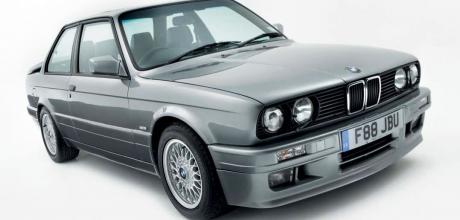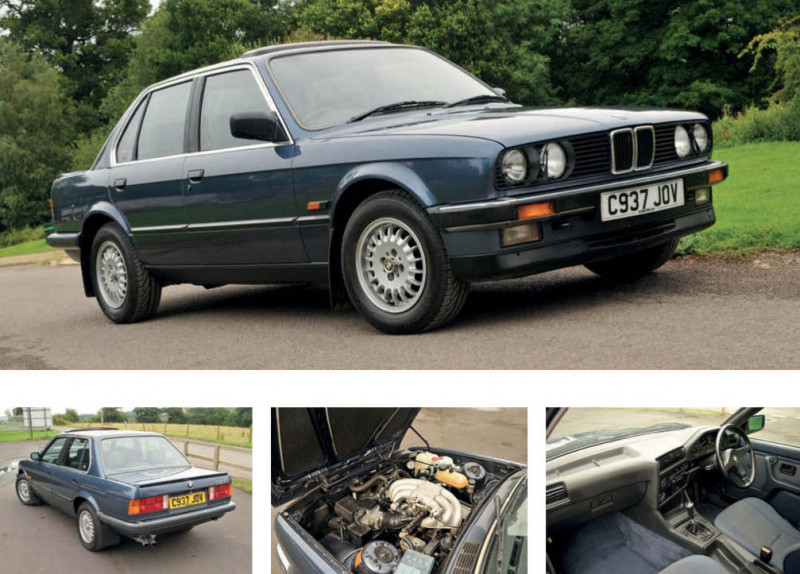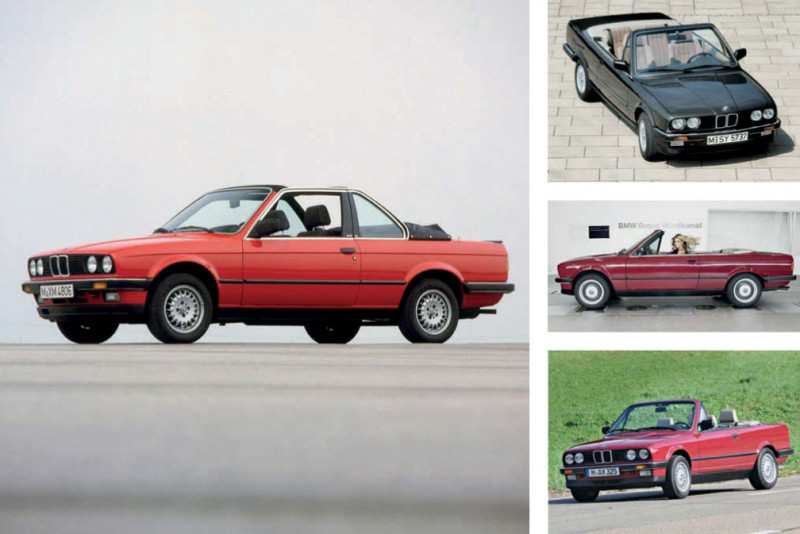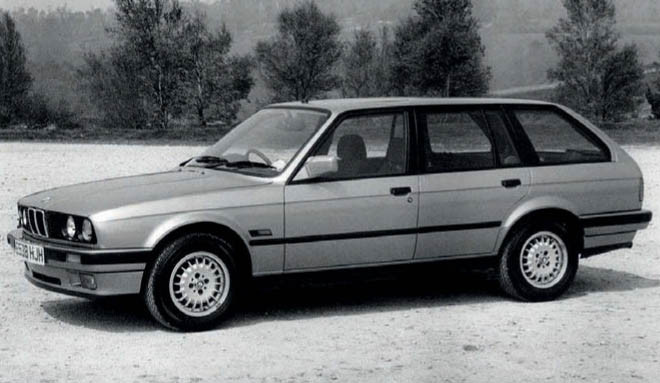History BMW E30

The life and times of the second-generation BMW 3-Series, a car which single-handedly invented the market we named after it.
Words: Andrew Everett
40 YEARS OF BMW’S E30 3-SERIES FACTS, FIGURES, HISTORY
It has been said of late that BMW as a company is in a tailspin, caught off-guard by Tesla and begging the question what exactly is a BMW these days and what exactly does it do? It seems that even BMW doesn’t know as it continues to drift off course to the extent that even one of the company’s past stylists has publicly condemned much of what it makes now.

Of course, by contrast BMW knew exactly what it was doing 40 years ago as it geared up for the launch of the second generation 3-Series, the model codenamed E30.
In gestation since 1979, the E30 is the car that really did catapult BMW into the big time and perhaps its success even caught its own maker unaware. In reality, the E30 was a well massaged and improved version of the 1975 ‘E21’ 3-Series, itself a good car but one that supposedly lived in the shadow of its smaller, lighter and spectacularly successful 2002 predecessor.
The E21 had moved BMW’s smallest offering upmarket with many improvements that overall amounted to a better car. It was bigger, heavier and slower but on the other hand it was roomier, more solidly built with a better ride, a much nicer interior and vastly better heating and ventilation.
Selling 1.3 million units between 1975 and late 1983 (the 316 overlapped slightly into E30 production), the E21 handsomely outsold the ’02 range by about half a million units so BMW was doing something right. Its successor would sell over 2.3 million units. The E21 had a few failings to sort out though. It was expensive to make because it shared so little with other BMW models and the more powerful versions were either quite thirsty (320 six-cylinder) or could be a bit lively in the wet – enter the 323i, a car trickier than Rasputin and one that prompted the Swedish authorities to look a bit closer at the car’s accident record.
EVOLUTION
The E30 would strive to correct most if not all of the E21’s wrongs. Computer aided design would produce a slightly larger, stiffer and more aerodynamic bodyshell that was a mere 7kg heavier as well as using lighter suspension. BMW at that time was still wedded to the semi-trailing arm rear suspension and if it was ever to abandon it, this would have been the time because the only parts in common with the old car were the bonnet and boot roundels. This isn’t like the traditional Mondeo versus X-Type Jaguar argument or Saab 93 owners trying to convince themselves that their car really isn’t a Vectra B underneath — in those cases, the differences are details and a different part number. No, the E30 really was very different and pretty much nothing will interchange. The semi-trailing arm independent rear end worked well anyway.
One of BMW’s main objectives was to make the E30 a lot more economical than the outgoing car whose 320 model with its oversized Solex 4A1 four barrel carburettor was particularly thirsty. BMW was to reuse all three engine types, these being the M10 four-cylinder in 1.8 litre carb (316) or fuel injection (318i) guises and the small straight six in 2.0 (320i) and 2.3 litre (323i) sizes.
The M10 was quite similar to before but used a lighter, thinner-walled iron block, the same alloy crossflow head, a deeper sump and the same Solex 2B4 carburettor as introduced on the E21 316 in late 1980.
The 318i engine received a similar lighter block and retained the Bosch K-Jetronic fuel injection system but this didn’t have long to go: after 12 months the engine was completely revised and used Bosch LE-Jetronic fuel injection at which point the 318i was launched here in RHD form. The straight sixes were however far more extensively revised with the new engine – renamed M20 from M60 – being fitted to the 520i as well.
With a lighter bock, the M20 featured Bosch LE-Jetronic injection, bigger inlet ports and more sophisticated electronic ignition with a complex vacuum advance and retard system. Power remained about the same at 122bhp but the new engine was far more fuel efficient.
The 323i received a similar update to its 2315cc motor but initial cars were considered a touch underwhelming at 139bhp after the 143 of the E21. By autumn of 1983, the camshaft, ECU and exhaust had been altered to boost power to 150bhp.
In terms of the transmission, things looked familiar but had been changed. There was no longer a speedometer cable thanks to an electronic sensor in the differential so the castings were altered and like before, the six-cylinder cars had a five-speed overdrive box as standard with the option of a close-ratio ‘sport’ unit or a three speed ZF automatic.
The 316 retained a standard four-speed but cars without the five-speed option were rare and the 318i that arrived on the UK market in late 1983 was also a standard five-speeder. The differential itself was essentially from the contemporary 5-Series and it sat in a rear axle beam with both trailing arms, all built to be lighter than before and featuring much reduced trailing arm operating angles.
It was at the front that BMW made the biggest improvements though. Previously, the MacPherson suspension looked pretty much like that of a Ford with simple control arms and a front-mounted antiroll bar slotting into them to both control roll and prevent longitudinal movement of the arms.
Now though, the E30 had a very compact subframe with a shorter anti-roll bar mounted behind with short links to the new wishbones. This time, BMW provided boomerang-shaped wishbones with the rear section bolted to the chassis legs for much better geometry control.
The result of all of this hard work was a car which was quieter, better riding, more economical (particularly at speed) and with much safer handling. Even a 316 with 90bhp was a delight to drive, with that perfect combination of usable performance, light controls and excellent driving position allied to great all round vision and a comfortable ride. The option of power steering was a popular one for it was perfectly weighted and reduced the number of turns lock to lock.
It was also lighter; weights such as 1150kg for an E21 320 seem laughable when compared to today’s bloated monsters but 1000kg for a basic E30 316 just seems astonishing. Even the 323i weighed in at just 1130 kg. “It’s much better thank you,” was BMW GB’s inspiring strapline upon launch. Not that the good news stopped there because BMW also offered the sybarite plenty of options that were just unavailable on the E21. Electric windows and central locking were the two big ones but leather trim, headlight wash-wipe, an on board computer, cruise control and factory fitted air conditioning were ‘big car’ options on BMW’s smallest model. The E30 also gained the slightly annoying Service Indicator system as first seen in the 1981 facelift 7-Series E23, that year’s 5-Series E28 and 1982’s revamped 6-Series E24.
Production began in late 1982 and the E30 was launched here in March 1983. The addition of a four-door model that September as well as the big selling 318i and new four-speed automatic 320i and 323i cars made BMW’s waiting list extend even further and it wasn’t until 1986 that the new Regensburg plant would open, relieving the enormous pressure on the original Munich Milbertshofen factory.
1984 would see a few changes, the biggest one being the final replacement of the old 3HP automatic transmission with the all new four-speed 4HP22 unit on the 316 and 318i as well as the launch of a Baur Cabriolet. BMW also started production of a car we were destined not to see in the UK, more’s the pity. The 325e combined the running gear of the 323i with its bigger stronger gearbox, final drive, front suspension struts and rear discs with the ‘Eta’ engine shared with the 525e. This economy-minded 2.7-litre engine used a bigger bore and a longer stroke allied to a small port E21 320 cylinder head with a very high 11:1 compression ratio, Bosch Motronic engine management and a special camshaft that helped the ignition map to concentrate power and torque in the 1200-3000 rpm rev range. Low friction piston rings were also used and the result was 125bhp at a low 4250rpm but 177lb. ft of torque at 3250rpm with most of that available at 2500rpm. This was exploited by a very tall final drive giving over 30 mph per 1000 rpm in top gear and the potential for a real 35-40 mpg at a steady 70 mph cruise. Quite popular in Europe, it was felt not to fit into the performance image BMW GB was trying to maintain, even though the 525e was quite a good seller in the 5-Series range.
THE 325I ARRIVES
1985 though would see even more changes, the most important being the replacement of the 150bhp 323i with the 171bhp 325i. By combining the bigger-bore block from the 2.7 Eta engine with a new shorter-stroke crank along with a clever new cylinder head and Bosch Motronic engine management, the 325i was a bona fide 135mph car. Elsewhere, all E30s had taller profile tyres (from 60 to 65 aspect ratio), lowered final drive ratios, new trim and front valance and the revised 320i offered 129bhp.
Almost as important although again not sold here was the 324d. This first 3-Series diesel used the four-door body and the non-turbocharged 2443cc straight-six diesel from the 524d with 86bhp and 112lb.ft of torque at 2500 rpm. The turbocharged 524td with 115bhp was a strong seller in Europe and a lack of production capacity at the Austrian Steyr plant meant that the 324td did not arrive until 1987.
1986 was a watershed year for the E30 with many new models and upgrades. This really was a golden era for BMW with the marque (not a brand) being all but unstoppable and aided by a very buoyant economy. First up came the 325i Convertible, an achingly desirable car for just about affordable money. Unlike the Targa top Baur converted in Stuttgart from a built-up car, the Convertible was a full soft top completely engineered and built by BMW with all the correct reinforcements.
For those who found a standard 325i a bit lacking, BMW gave you two new models in ’86. First up was the 325i Sport, a UK-market model based on the German ‘Sportpaket’ 320i and 325i. The 325i Sport was available in three metallic colours, Lachs Silver, Dolphin Grey and Diamond Black. All the chrome and stainless was replaced by black with body-coloured bumpers and the M Technic bodykit, this comprising aprons and sills plus a chunky boot spoiler. Uprated suspension with thicker anti-roll bars, Bilstein dampers and shorter, stiffer springs was fitted along with a limited-slip differential, a closer ratio overdrive gearbox and 15-inch BBS cross-spoke alloy wheels were used.
Inside, Recaro-style BMW sports seats in cloth or optional leather were allied with a black headlining and an M Technic sport steering wheel. ABS had just been standardised on the 325i as well. This was a superb package that really honed the 325i into a proper weapon. If Ford had abandoned the rear drive performance car, BMW picked up the baton and really ran with it.
Not only that, but BMW briefly imported the four-wheel drive 325iX with deliveries via special order beginning in April 1987. Left hand drive only and £1100 more than a regular 325i SE, it was never going to sell well and it was quietly dropped in 1988.
A NEW STYLE
1987 was also the year that saw the five-year old E30 facelifted and improved and with another new model added. The facelift was quite mild: bigger tail lights, plastic impact bumpers, reshaped front and rear valances and new headlights plus a mod that almost nobody noticed. The lower cut rear arches from the convertible were adopted but the soft top E30 remained defiantly metal bumper until October 1990.
Whilst the interior remained largely unchanged, there were quite a few mechanical revisions. The biggest of these was the new M40 1.8-litre four cylinder engine for the 318i, an all-new design. Smaller, lighter, more powerful and economical, the M40 featured a toothed rubber camshaft belt, rocker fingers and hydraulic tappets and it was a designed alongside the M70 5-litre V12 used in the 750iL with components for both being machined on the same line. A 316i version would arrive in autumn 1988, bringing to a close production of the now 26 year old M10 unit.
The 320i and 325i cars were revised with different compression ratios as well as Motronic 1.3 engine management already prepared for a catalytic converter. Equally important was a new 325i Touring estate: like the Convertible that was now available as a 320i from October, this expensive but trendy car arrived here in April 1988 and would soon be available as a 320i, 318i and lastly a 316i. The Touring began life as an afterhours conversion on a four-door saloon but when BMW top brass chanced up on it, the green light for development for production swiftly followed. How many 3 Series Touring have been built since?
The 1987 324td was not only about the quickest four-door diesel saloon anywhere with a 116 mph top speed and 11.6 second 0-60 time, but with a real 45mpg potential it would have made every other diesel in the UK look very poor. BMW undoubtedly made a mistake by not importing the 3 and 5-Series turbodiesels into the UK where they would have stolen a huge lead and dominated the performance diesel market, leaving it instead to the first Golf TDi.
1988 saw the aforementioned 316i M40 but it also saw a number of very good saloon cars from other manufacturers: the facelifted Mercedes Benz 190E W201 was one and the Peugeot 405 was another. It may not have competed on build quality but it was a roomy four-door saloon that drove extremely well. Of course, BMW was well into the E36 project that would redefine BMW again for the 1990s and the 1988 launch of the new E34 5 Series – easily the best mid-size saloon anywhere – took the heat off the ageing E30 somewhat. Arriving a year after the facelift, the popular 325i Sport reappeared in October 1988. With a wider colour range that included bright red, the 1988 Sport featured the same recipe as last time albeit with softer Boge dampers and an all new bodykit.
1989 was a quiet year for the E30 with just the 318i Touring and Convertible arriving as new models but 1990 saw a few new variants arrive. Most important was the 318is that arrived in the UK in February. Available as a two-door only, the new 318is featured the new M40-based twin cam 16-valve M42 engine with 136 bhp.
The 318is was brisk enough with a 9.3 second 0-60 time and a top speed of 125mph but like the 320i, the 0-60 time would have been better but for the low 4.1 ratio final drive ratio. This meant that it couldn’t get to 60 in second gear meaning a change up to third.
However, the 0-100 time of 26.6 seconds compared well with the 33 seconds of a 318i and showed the top end potential of the M42 unit that featured hydraulic tappets and a duplex timing chain rather than a belt.
It also used the latest Motronic engine management with a big coil pack unit operating four plugs thus dispensing with the distributor cap and rotor arm.
Colours were restricted to Royal Blue and Diamond Black metallics along with Sterling Silver, Alpine White and Brilliant Red with no golds or greens thanks. 5.5-inch wide steel wheels with 195/65HR14 tyres and unique plastic wheel trims could be replaced with 6.5-inch wide 14-inch Style 5 BBS alloy wheels and identical tyres or 7x15 Style 5 BBS alloys with 205/55VR15 rubber.
The 318is used 325i-spec M Technic suspension and a five-speed manual gearbox was the only choice along with 325i-spec brakes with optional ABS.
Externally, the 318is used black trim around the windows, body colour bumpers, door mirrors and small boot spoiler and a new body coloured deep front chin spoiler unique to the 318is. A new 318is boot script finished off the exterior whilst inside, BMW sports seats were trimmed in M3 style tartan cloth with a three-spoke M Technic 1 steering wheel.
THE END
By late 1990, the beginning of the end was upon the E30 as the production of saloons ended and pilot-build left hand drive E36 cars began.
In January 1991, full production was underway with just Convertible and Touring models continuing; of the convertibles, 320i and 325i production ended in January 1993 and the 318i model in April. The Touring would live longer — the 320i was the first to go in January 1991 followed by the 325iX in December 1992 and the 325i and 324td in April/May 1993. The last ever E30s came down the line in February 1994, these being 316i and 318i as supplies of M40 engines ran out (it had been replaced by the M43 in the newer cars).
The E30 had been a massive success for BMW and it opened up the UK market nicely. Whilst the actual volumes were nowhere near Ford or Vauxhall levels, pretty much every car was built to order and you could forget about discounts — they were forbidden.
With the E30, a niche was created for a well-made compact saloon that drove well, was expensive yet still attainable and all from a clean and modern dealer network that was simply light years away from the volume brands.

A pre-facelift 325i saloon showing the higher rear arches and metal bumpers. Boot spoiler and cross-spoke alloy wheels were signature Sport features.
The all-wheel drive 325ix was briefly offered as a special order in the UK. BMW’s ‘small six’ in 325i form boasted 171bhp.
Bodykitted 325i Sport was a UK-market model and is now highly sought after.
The E30 introduced the four-door model to the 3-Series.
Styling was a neat evolution of the previous generation.
The 316 and 318i carried over the long-serving M10 engine.

Targa-topped Baur (above) lacked the elegance of the factory-made full convertible (above right).

The estate, marketed as Touring, inspired a new generation of upmarket imitators.
SPECIFICATIONS
- MODEL 316 M10 316I M40 318I M10 318I TOURING M40 318IS M42 320I M20 323I M20
- ENGINE 1766cc I4 1596cc I4 1766cc I4 1795cc I4 1795cc I4 1990cc I6 2315cc I6
- MAX POWER 90bhp 102bhp 105bhp 119bhp 136bhp 125bhp 150bhp
- TOP SPEED 109mph 114mph 112mph 115mph 125mph 122mph 127mph
- 0-60 12.4secs 10.1secs 10.7secs 10secs 9.3secs 9secs 8.4secs
- WEIGHT 1000kg 1109kg 1077kg 1061kg 1160kg 1103kg 1130kg
SPECIFICATIONS
- MODEL 324TD M21 325E M20 325I M20 M3 S14 M3 EVO I S14 M3 SPORT EVO S14
- ENGINE 2443cc I6 2693cc I6 2494cc I6 2302cc I4 2302cc I4 2467cc I4
- MAX POWER 115bhp 122bhp 171bhp 200bhp 220bhp 238bhp
- TOP SPEED 116mph 121mph 132mph 142mph 148mph 154mph
- 0-60 11.6secs 9.3secs 7.2secs 6.9secs 6.6secs 6.5secs
- WEIGHT 1260kg 1162kg 1140kg 1230kg 1274kg 1200kg
THE M3
BMW had raced the 323i and latterly the 325i but the two-valve M20 engine was never going to be a race winner against the cars the M3 raced against. Starting from scratch with a two-door shell, BMW Motorsport redesigned the suspension, keeping the basic layout but changing absolutely everything from bushes to mounting points and geometry.
The arches were made wider, the rear screen modified via an add on panel and a new raised bootlid to give a greater rake for better aerodynamics, the front screen bonded in and new plastic front spoiler designs.
The engine was a new 16-valve four based on the S38 unit from the M5 with throttle bodies and 200bhp and the gearbox was a close-ratio Getrag unit similar to that used in the M535i. Add a limited-slip diff, bigger brakes, a quicker-ratio steering rack and sports seats and this was quite unlike a 325i. Built in the main BMW production facility, over 17,000 were built in lefthand drive form only. A Convertible arrived in May 1988 with just 786 built. There were three evolution models: 505 Evo 1 cars between February and May 1987, 501 Evo 2 cars with 220 bhp from March to May 1988 and 600 2.5 litre 238 bhp Evo 3 (Sport Evolution) between December 1989 and March 1990. Limited editions named after BMW racing drivers included the April- June 1989 M3 Johnny Cecotto with 215 bhp in Nogaro Silver, Misano Red or Macao Blue again and the UK version, the M3 Roberto Ravaglia in Misano Red only. Finally, the M3 Europa Meister was an October/November M3, bog standard with the catalysed 195bhp engine and in Macau Blue.
Regular M3 production ended in early 1990 and the convertible in 1991.

